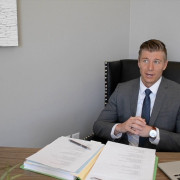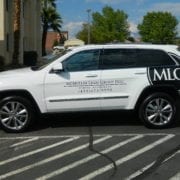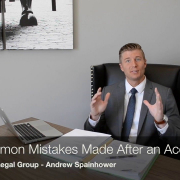Top 5 Most Common Causes of Car Accidents
Top 5 Most Common Causes of Car Accidents
People cause accidents in many different ways, but typically the cause can be categorized into a few basic careless mistakes that even good drivers make from time to time. Being aware of the increased probability of a collision that these actions create can help drivers prevent dangerous and expensive consequences. These top five mistakes are common among the best of us, but are easy to avoid. A little extra time and focus can save a lot of money, stress, and likely even save a life.
-
Distracted Driving
One of the most common causes of serious accidents is distracted driving. Distracted driving may also be the most common cause of all accidents in general. Distracted driving accidents are serious because when a driver is not focused, he or she is not able to slow before a collision, while a focused driver might be able to slow enough to decrease the impact of the crash. Some of the more common forms of distracted driving are texting while driving, making a phone call, or using a cell phone in any way. In Utah, the new cell phone law says that use of your cell phone that requires the use of your hands while driving is illegal. To clarify, scrolling social media, surfing the web, or sending a text are clear violations of Utah law and prime examples of dangerous distracted driving behavior. However, use of a Bluetooth device, brief or hands-free use of GPS, or voice-activated features are allowed while driving in the state. There are numerous other ways a driver could be distracted while driving: eating while driving, getting distracted by something on the roadside, attempting to multitask during a commute, or a passenger causing a commotion in the vehicle. If a driver is distracted by anything inside or outside the vehicle, their reaction time is severely compromised, potentially leading to serious accidents, injury, and expense. A phone call or text might seem urgent at the moment but is never worth the risk. Being a focused driver can be difficult, but it makes a big difference in your safety and the safety of those around you. It is wise to practice observing objects at a distance as you drive, or try talking out loud about what you see and how you are reacting as a safe driver. Such mindfulness practices can make focused driving a little easier.
-
Shooting gaps
The roads can often get quite crowded and busy in St. George and other Utah cities such as Cedar City, and people often grow impatient and try what is referred to as “shooting a gap,” or darting their car out into traffic while changing lanes, merging, or turning, although there is not actually sufficient time or distance. This is a very common misstep and an unsafe alternative to waiting for a larger clear break in traffic before making a safe maneuver. Shooting gaps can be especially dangerous when a driver is making a left-hand turn, whether at an intersection or from private property out into a main road or highway. Left-hand turns are generally the most dangerous turns to make because they often require a driver to cross a higher number of lanes of moving traffic to make the turn than a right-hand turn does. Left-hand turns that are rushed and poorly judged cause accidents that can happen at stop signs, traffic lights, or simply while a driver attempts exiting a parking lot. Often drivers may misjudge speeds and distances of oncoming vehicles. If a driver pulls out in front of an oncoming vehicle close enough, according to the Utah law, “so as to constitute an immediate hazard,” then that driver will be at fault for the accident, not the driver that could not stop in time to avoid the collision. The driver “shooting the gap” will be cited for a collision in such a case. A driver passing on the main roadway or highway has the right of way and must be allowed time and space to safely make their way through. Additionally, the driver traveling straight has the legal right in the state of Utah to assume that other drivers will not pull out or cause a hazard in the roadway front of them. Hence, pulling out in front of another driver or “cutting them off,” without giving them time to slow down and avoid a collision puts you at fault for an accident. Whether the driver traveling straight has time to slow, or hits the other vehicle at full speed, the vehicle “shooting the gap” will still be at fault for the accident, by way of causing an immediate hazard in the roadway. It is best practice as a safe driver to wait patiently for large, generous gaps in traffic before pulling out to turn or merge. Patience can help drivers to steer clear many dangerous and avoidable accidents and injuries.
-
Speeding
Speeding creates circumstances in which the severity of accidents that occur is heightened considerably, and perhaps more importantly, speeding delays the time that people have in order to respond to one another’s actions in traffic. Speed limits are put in place on roadways for a reason; the specified speed is determined to be safe for the conditions that are typically present on that particular road. Utah law actually dictates that drivers must drive at a reasonable speed for the current road conditions, with the marked speed limit set as an absolute maximum. For example, in construction zones, heavy business traffic, limited visibility, inclement weather, or other dangerous conditions, a driver may not legally assume that he or she can always drive at the speed limit as posted automatically. Drivers are legally required to slow down and observe hazards in the roadway before proceeding at a cautious speed. If a driver is traveling at a speed faster than reasonable for the conditions of the road, he or she creates danger for everyone around, including passengers, pedestrians, and other drivers. If one driver stops suddenly in front of another driver, the second driver will need time to react quickly. In addition, drivers in the proximity of one another might reasonably expect each other to be driving more slowly according to the speed limit, and then one driver could cut another driver off inadvertently, causing injury or accident to one or both parties. Speeding can often cause, and ultimately worsen, many different types of dangerous scenarios and collisions.
-
Cutting it too close at stop lights.
Accidents at traffic lights can be very severe and traumatic, causing brutal damage to vehicles and patients. Vehicles are often t-boned in intersections on major roads, causing serious injury, or perhaps even fatality. This occurs when the front end of one vehicle collides with the driver- or passenger-side door of another car, directly where a person is positioned in the vehicle. These particular types of accidents can cause major damage and injury, even if the impact is not necessarily great, simply because of the proximity of the impact to the position of the driver or passenger sitting in the car. Accidents at intersections are sometimes caused by distracted driving, leading a driver to run a red light. But oftentimes, the driver is not distracted at all, but instead, trying to speed through a yellow light and avoid stopping at the intersection altogether. When this happens, things typically play out the same way each time: a light turns yellow, and an approaching vehicle speeds up instead of slowing down as they come to and travel through the intersection. In the seconds that follow this vehicle’s acceleration, the traffic light may turn red, and the crossing traffic may begin to proceed into the intersection, and that is exactly prime time for a dangerous accident to easily occur. One helpful tip here for defensive driving is to treat a green light as you would a stop sign and take a quick glance in either direction to make sure the roadway is clear and that traffic is stopped completely on both sides before you proceed to cross the intersection. This tip applies especially if the light has only just turned green. Checking the intersection in this manner before proceeding at a green light can prevent a great number of accidents, as can slowing and stopping each time you approach a yellow light. As long as you can safely stop in the remaining distance before you reach the intersection, you should always stop when a traffic light turns yellow.
-
Following too Closely
The number one most common type of accident on our roadways is a rear-end collision. Rear-end collisions can be caused by a combination of other common causes of accidents: sometimes a driver is distracted while driving; sometimes a driver is speeding; and sometimes a driver is following too closely for the conditions of the road. In short, this means the driver does not leave enough space between their vehicle and the vehicle in front of them, in order to safely see the conditions ahead of their car with enough time to react in case of a hazard. Each driver needs enough space in front of their vehicle to respond to emergency conditions by slowing in time to avoid a collision. It is wise to remember that you always want to follow the vehicle driving ahead at a safe distance, specifically by leaving at least three seconds between your vehicle and the one ahead of you, in cases of perfect driving conditions, according to Utah driving law. However, it is equally important to keep in mind that for added interfering driving conditions, such as rain, snow, fog, construction, heavy traffic, or even stress, Utah law actually requires drivers to create an additional one second of distance for each hazardous or distracting condition. These laws are in place to allow drivers the likelihood of having enough time to slow and stop in the case of a hazard in the road that may cause an accident, particularly a rear-end collision. If you do have the misfortune of causing a rear-end collision, it is very likely that you will be cited for following too closely, and perhaps even other traffic violations as well. Although there may be other external reasons that the rear-end collision occurred, the citation for following too closely is somewhat of a default. However, you may have been able to stop had there been more distance when those other outside complications or hazards arose in the roadway or traffic. In almost every case of a rear-end collision, a driver is cited for following too closely, and these accidents are all too common even for the most experienced drivers.
These are the five most common causes of car accidents. By being aware and avoiding these common pitfalls and mistakes, you can be a safer driver. Hopefully, you will be able to take comfort in knowing that a few simple tweaks to your driving habits can keep your loved ones safe, your driving record clean, and your hard-earned money in your pocket.






